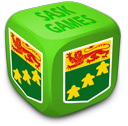As a bonafide fan of abstract strategy games I am quite surprised it has taken so long to find and explore Wizard's Garden.
The game was designed by Tim Schutz back in 2004. Known then as Wizard's Garden - The Alesalitis Plant it was a finalist in the 2004 About.com Board/Card Games/Abstract Games Magazine Shared Pieces Game Design Competition.
Now the game is being published by XV Games, a company only launched in 2018, with the neat motto: "one minute for the rules, one life for the play".
No game XV Games will ever produce more closely fits their motto than Wizard's Garden.
The website explains the game as; "a classical abstract game of the Reversi family, Wizard's Garden has its strength in shared pieces and non-intuitive strategical gameplay."
It is the neat shared piece mechanic that really makes this game a winner, but more on game play in a bit.
This first tabletop edition by XV Games comes with embossed wooden discs in a velvet bag with the board printed on it, making the version a highly portable one.
The concern here might be that when you take the game to the coffee shop and it gets coffee spilled on the bag, and such things happen, will the board design be lost if you try to wash the bag? It's a small quibble, but it is a possible drawback.
On the positive side the play area is a 4X4 grid which is rather easy to replace.
This game is brilliantly simple.
Players initially take turns placing four pieces on the board. Pieces are double sided but it does not matter which side is showing in set up. They must however note be connected orthogonally.
A piece is flipped, the other player calling the colour. Whoever wins the flip goes first.
Game play now proceeds with each player in turn dropping a stone of either colour on an empty cell orthogonally adjacent to at least another stone on the board. All stones orthogonally adjacent to the played pieces then flip colour.
After the flips, any four in-a-row (with stones of the same colour) is removed from board, and that player gets one point. He keeps one of the pieces in his scoring pool, and the remaining three go back to the shared piece pool.
The game ends when there are no moves available. The one with the most points wins.
There is a built in tie breaker that is neat but a tad more detail than needed here.
This game is simply fantastic. It's simple to learn, quick to play, with a lot of replay allure, and it's highly transportable. This is a game that is not only recommendable, but should be in any collection if someone liking the abstract strategy genre. I may have taken 15 years to finally play it, but it was certainly a game worth discovering.
Check it out at www.xvgames.it
Thanks to fellow gamers Trevor Lyons and Adam Daniels for their help in running through this game for review.
The game was designed by Tim Schutz back in 2004. Known then as Wizard's Garden - The Alesalitis Plant it was a finalist in the 2004 About.com Board/Card Games/Abstract Games Magazine Shared Pieces Game Design Competition.
Now the game is being published by XV Games, a company only launched in 2018, with the neat motto: "one minute for the rules, one life for the play".
No game XV Games will ever produce more closely fits their motto than Wizard's Garden.
The website explains the game as; "a classical abstract game of the Reversi family, Wizard's Garden has its strength in shared pieces and non-intuitive strategical gameplay."
It is the neat shared piece mechanic that really makes this game a winner, but more on game play in a bit.
This first tabletop edition by XV Games comes with embossed wooden discs in a velvet bag with the board printed on it, making the version a highly portable one.
The concern here might be that when you take the game to the coffee shop and it gets coffee spilled on the bag, and such things happen, will the board design be lost if you try to wash the bag? It's a small quibble, but it is a possible drawback.
On the positive side the play area is a 4X4 grid which is rather easy to replace.
This game is brilliantly simple.
Players initially take turns placing four pieces on the board. Pieces are double sided but it does not matter which side is showing in set up. They must however note be connected orthogonally.
A piece is flipped, the other player calling the colour. Whoever wins the flip goes first.
Game play now proceeds with each player in turn dropping a stone of either colour on an empty cell orthogonally adjacent to at least another stone on the board. All stones orthogonally adjacent to the played pieces then flip colour.
After the flips, any four in-a-row (with stones of the same colour) is removed from board, and that player gets one point. He keeps one of the pieces in his scoring pool, and the remaining three go back to the shared piece pool.
The game ends when there are no moves available. The one with the most points wins.
There is a built in tie breaker that is neat but a tad more detail than needed here.
This game is simply fantastic. It's simple to learn, quick to play, with a lot of replay allure, and it's highly transportable. This is a game that is not only recommendable, but should be in any collection if someone liking the abstract strategy genre. I may have taken 15 years to finally play it, but it was certainly a game worth discovering.
Check it out at www.xvgames.it
Thanks to fellow gamers Trevor Lyons and Adam Daniels for their help in running through this game for review.
